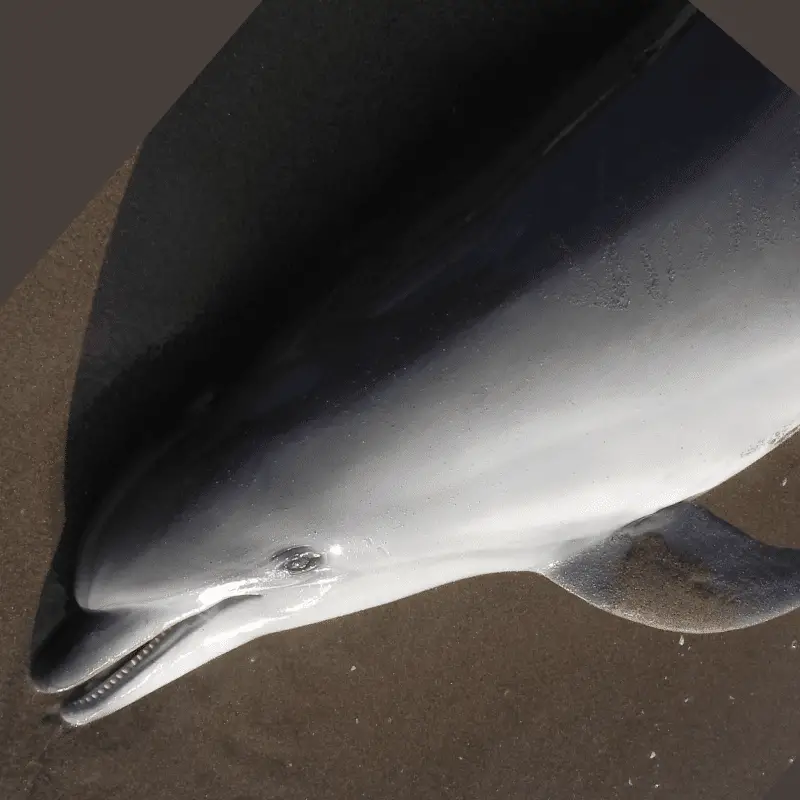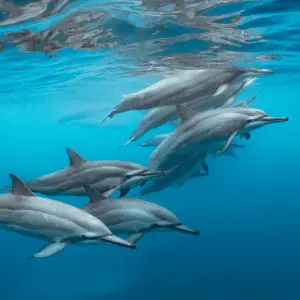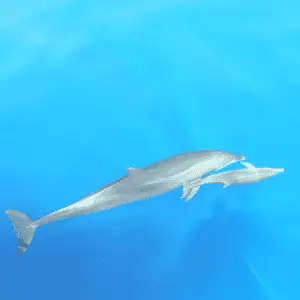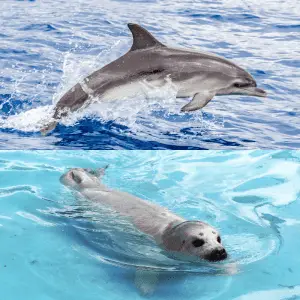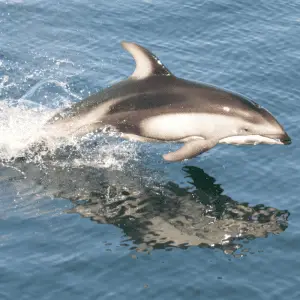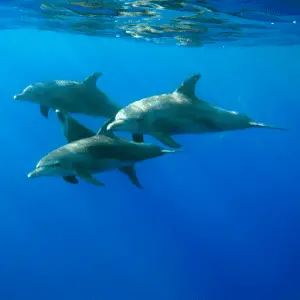Dolphins can’t survive on land because their bodies have evolved to live underwater. If they don’t stay in the water, they will die. Also, their limbs won’t support them when they go onto land, and their skin will become dehydrated and damaged from the sun. They also need the diet of fish and other sea creatures found in the water to survive.
Dolphins, in fact, evolved from land creatures, small deer-like terrestrial mammals called the Pakicetus. The adaptions allowed the dolphins to survive in water rather than on land.
The reasons why they can’t survive on land are below!
Food On Land Is Not Enough
Dolphins need a steady consumption of fish or other aquatic animals to survive. Most dolphins can consume food that weighs about one-third of their body weight. If dolphins started to live on dry land, it would be impossible for them to hunt and maintain this continuous food source.
Limbs Are Too Weak To Move Around On Land
The limbs of a dolphin are not structured to live on dry land. Their limbs are only made up of dense fibrous connective tissue, and there are no bones or muscles to support any weight. Dolphins cannot hold their weight when they get stranded on land.
Dolphins live in the water without worrying about weight, as buoyancy helps them move around without much effort. But once they get on the land, gravity impacts them in the same way it affects all the other terrestrial animals.
Living On Land Will Cause Dehydration
Though they need air, dolphins are not classed as semi-aquatic animals. Unlike the hippos, these animals can live and survive on land and water.
Dolphins will face another problem if they ever live on land or get accidentally stranded: dehydration.
Like all other aquatic animals’ dolphins also need water in their surroundings to stay hydrated. Dolphin skin is impossible to manage the hydration requirements on dry land.
This life-saving technique is often used when dolphins become accidentally stranded—keeping them wet using the water nearby and soaking material to lay on them. A dolphin could survive for several hours, even on dry land.
A stranded dolphin will always need help in returning to the water. Even though dolphins can breathe in the air, they do not have strong enough limbs to move around in the dry land to get them back to the water.
Sun Rays Will Be A Big Problem
Another problem dolphins face if they start living on dry land is the heat. The dolphins need to stay in the water to survive. They need to keep their skin wet all the time. But their skin quickly becomes extremely dry when they come out of the water. In this situation, the dolphin’s skin will start to crack and burn within an hour if it stays under direct sunlight. This situation gets even more severe if the weather is hot.
Blowhole Is Too Perfect for Surviving In Water
The breathing process of the dolphins is quite similar to that of a whale. That means the whales’ dolphins also have a blowhole located directly at the top of their heads. Using this blowhole, the dolphins exhale carbon dioxide and all the remaining air in their lungs and breathe fresh air full of oxygen.
The exhaling process is quite powerful. Whenever a dolphin needs to take a breath, it comes to the surface of the water and reaches the surface. During that short period, it exhales through the blowhole before taking its next breath.
The dolphins spray water during this process, known as the Dolphin Spout.
The characteristics of these spouts are different among various species of dolphins.
Related Questions you may find of interest from the above information!
Can dolphins suffocate on land?
Since dolphins have lungs, they do not have difficulty breathing when out of water. As they do not have gills like fish, they must come up to the water’s surface to breathe.
Instead of suffocating the dolphins, most of the time, dolphins die on land due to dehydration and excessive heat. The bodies of the dolphin have evolved so that they can only function when living in the water.
The breathing process of the dolphins is voluntary. That means they can decide when to take a breath and when to hold it.
While diving into the water, the dolphins hold their breath. On average, the dolphins can hold their breath for 8 to 10 minutes. A couple of dolphin species can hold their breath for more than 15 minutes.
But it entirely depends on what activity they are doing. If the dolphins stay in the water for too long, there is a high chance of death due to suffocation.
There are several pieces of evidence that the dolphins have died because they could not come up to the water’s surface for a fresh breath.
How long can a dolphin hold its breath?
A dolphin can hold its breath for eight to ten minutes at any time. After this time, a dolphin will need to resurface for oxygen.
How much does a dolphin weigh?
Depending on the dolphin species, they can weigh anywhere from 23 kg to 4,000 kg. Common Bottlenose weighs 150 – 650 kg, and Hector’s dolphin spices are roughly 50 kg. Orcas are the heaviest, up to 4,000 kg.
Why don’t dolphins have gills?
Dolphins are mammals that have evolved so that they can lead aquatic life. But as these animals are mammals, they do not have gills for breathing underwater. Evolution can only adapt so much, and gills were not required or entirely out of its powers.
Do dolphins have limbs?
Dolphins have limbs. These limbs are boneless and made of dense fibrous connective tissue with no muscle or cartilage. Dolphins’ limbs are found on either side of their body at the front, called flippers. They have a tail of flukes on the back, and on top, they have a dorsal fin.
How do dolphins keep water out of their blowhole?
After the dolphins take a breath, they seal the blowhole tightly using their strong muscles that surround it perfectly. This watertight stoppage ensures that no water drops into a dolphin’s lungs.
How To Help A Stranded Dolphin
If a dolphin is stranded, splash water to keep it cool and wet. Make sure not to put water in the blowhole. Put wet towels and t-shirts on the dolphin’s body and provide shade if possible. Do not cover any of its fins or tail with objects.

